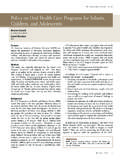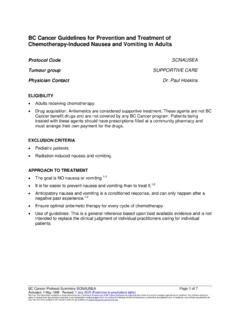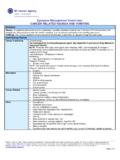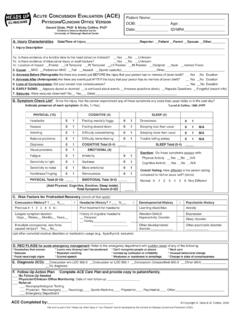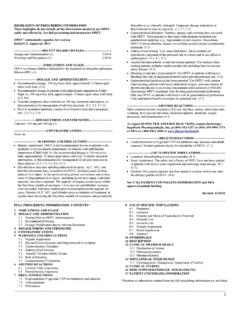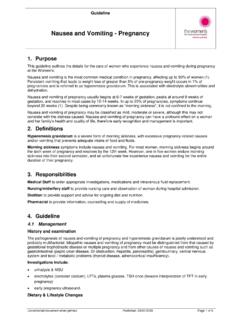Transcription of Guideline on Management of Acute Dental Trauma
1 202 CLINICAL GUIDELINESrEfErENCE mANUAL v 32 / N o 6 10 / 11 PurposeThe American Academy of Pediatric Dentistry (AAPD) intends these guidelines to define, describe appearances, and set forth objectives for general Management of Acute trau-matic Dental injuries rather than recommend specific treat-ment procedures that have been presented in considerably more detail in text-books and the Dental /medical Guideline is an update of the previous document re- vised in 2007. It is based on a review of the current Dental and medical literature related to Dental Trauma . An elec- tronic search was conducted using the following parameters: Terms: teeth , Trauma , permanent teeth , and primary teeth ; Field: all fields; Limits: within the last 10 years; humans; English.
2 There were 5269 articles that matched these criteria. Papers for review were chosen from this list and from references within select articles. In addition, a review of the journal Dental Traumatology was conducted for the years 2000-2009. When data did not appear suf- ficient or were inconclusive, recommendations were based upon expert and/or consensus opinion including those from the 2008 AAPD Symposium on Trauma : A Comprehensive Update on Permanent Tooth Trauma in Children (Chicago, Ill). The recommendations are congruent with the 2007 guidelines developed by the International Association of Dental Facial Trauma that results in fractured, displaced, or lost teeth can have significant negative functional, esthetic, and psychological effects on ,5 Dentists and physicians should collaborate to educate the public about prevention and treatment of traumatic injuries to the oral and maxil-lofacial region.
3 The greatest incidence of Trauma to the primary teeth occurs at 2 to 3 years of age, when motor coordination is The most common injuries to permanent teeth occur secondary to falls, followed by traffic accidents, violence, and All sporting activities have an asso- ciated risk of orofacial injuries due to falls, collisions, and contact with hard The AAPD encourages the use of protective gear, including mouthguards, which help dis- tribute forces of impact, thereby reducing the risk of severe ,14 Dental injuries could have improved outcomes if the public were aware of first-aid measures and the need to seek immediate Because optimal treatment results follow immediate assessment and care,18 dentists have an ethical obligation to ensure that reasonable arrangements for emergency Dental care are The history, cir- cumstances of the injury, pattern of Trauma , and behavior of the child and/or caregiver are important in distin- guishing nonabusive injuries from Practitioners have the responsibility to recognize, dif- ferentiate.
4 And either appropriately manage or refer children with Acute oral traumatic injuries, as dictated by the com- plexity of the injury and the individual clinician s training, knowledge, and experience. Compromised airway, neurolog- ical manifestations such as altered orientation, hemorrhage, nausea / vomiting , or suspected loss of consciousness requires further evaluation by a physician. To efficiently determine the extent of injury and cor- rectly diagnose injuries to the teeth, periodontium, and associated structures, a systematic approach to the Trauma - tized child is ,22 Assessment includes a thorough medical and Dental history, clinical and radiographic exam- ination, and additional tests such as palpation, percussion, sensitivity, and mobility evaluation.
5 Intraoral radiography is useful for the evaluation of dentoalveolar Trauma . If the area of concern extends beyond the dentoalveolar complex, extraoral imaging may be indicated. Treatment planning takes into consideration the patient s health status and developmental status, as well as extent of injuries. Advanced behavior guidance techniques or an appropriate referral may be necessary to ensure that proper diagnosis and care are given. Guideline on Management of Acute Dental TraumaOriginating Council Council on Clinical AffairsReview CouncilCouncil on Clinical AffairsAdopted 2001 Revised2004, 2007, 2010 AmErICAN ACADEmy of pEDIAtrIC DENtIS try CLINICAL guidelines 203 All relevant diagnostic information, treatment, and recom-mended follow-up care are documented in the patient s record.
6 Appendix I is a sample document for recording assessment of Acute traumatic injuries. This sample form, developed by the AAPD, is provided as a practice tool for pediatric dentists and other dentists treating children. It was developed by pediatric dentistry experts and offered to facilitate excellence in practice. This form, however, does not establish or evidence a standard of care. In issuing this form, the AAPD is not engaged in rendering legal or other professional advice. If such services are required, competent legal or other professional counsel should be sought. Well- designed follow-up procedures are essential to diagnose complications.
7 After a primary tooth has been injured, the treatment strategy is dictated by the concern for the safety of the permanent ,21,23 If determined that the displaced primary tooth has encroached upon the developing per- manent tooth germ, removal is ,6,24-28 In the primary dentition, the maxillary anterior region is at low risk for space loss unless the avulsion occurs prior to ca- nine eruption or the dentition is Fixed or re- movable appliances, while not always necessary, can be fabricated to satisfy parental concerns for esthetics or to return a loss of oral or phonetic When an injury to a primary tooth occurs, informing parents about possible pulpal complications, appearance of a vestibular sinus tract, or color change of the crown associated with a sinus tract can help assure timely inter- vention, minimizing complications for the developing succedaneous ,6,29,30 Also, it is important to caution parents that the primary tooth s displacement may result in any of several permanent tooth complications, includ- ing enamel hypoplasia, hypocalcification.
8 Crown/root dilacerations, or disruptions in eruption patterns or se- The risk of Trauma -induced developmental disturbances in the permanent successors is greater in children whose enamel calcification is ,31 The treatment strategy after injury to a perma-nent tooth is dictated by the concern for vitality of the periodontal ligament and pulp. Subsequent to the initial Management of the Dental injury, continued periodic monitoring is indicated to determine clinical and radio-graphic evidence of successful intervention (ie, asymp- tomatic, positive sensitivity to pulp testing, root continues to develop in immature teeth, no mobility, no periapical pathology).
9 1,2,21,24,32 Initiation of endodontic treatment is indicated in cases of spontaneous pain, abnormal response to pulp sensitivity tests, lack of continued root formation or apexogenesis, or breakdown of periradicular supportive ,2,21,24,32 To restore a fractured tooth s normal esthetics and function, reattachment of the crown fragment is an alternative that should be ,24,33 To stabilize a tooth following traumatic injury, a splint may be ,34-38 Flexible splinting assists in ,39 Characteristics of the ideal splint include: 1. easily fabricated in the mouth without additional Trauma ; 2. passive unless orthodontic forces are intended; 3.
10 Allows physiologic mobility; 4. nonirritating to soft tissues; 5. does not interfere with occlusion; 6. allows endodontic access and vitality testing; 7. easily cleansed; 8. easily removed. Instructions to patients having a splint placed include to: 1. consume a soft diet; 2. avoid biting on splinted teeth; 3. maintain meticulous oral hygiene; 4. use chlorhexidine/antibiotics if prescribed; 5. call immediately if splint : incomplete fracture (crack) of the enamel with-out loss of tooth : normal gross anatomic and radiographic appear-ance; craze lines apparent, especially with objectives: to maintain structural integrity and pulp ,40,41 General prognosis: Complications are fracture uncomplicatedDefinition: an enamel fracture or an enamel-dentin fracture that does not involve the pulp.



